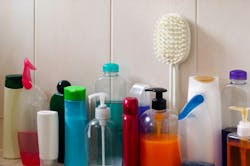Some groups of contaminants are of emerging concern for the U.S. Environmental Protection Agency (EPA) because they can affect aquatic life and they threaten drinking water sources. These contaminants include pharmaceuticals and personal care products such as shampoo, body washes, lotions and hair care products. Another group of contaminants is referred to as perfluorinated compounds (PFCs). This group is also emerging as a threat to drinking water resources and aquatic life.
PFCs are used in a large variety of items with which people come in contact daily. Products in which PFCs are present include fast food wrappers, carpet and furniture spray protection, rain coats, water repellent sprays, firefighting foams and Teflon cookware. These contaminants are increasingly found in more bodies of water at low levels. One of the greatest concerns with some these emerging contaminants is that many are considered endocrine disruptors, which are known to interfere with typical hormone functions. A disruption in hormone functions can be devastating to aquatic life. Another major concern is that PFCs are also persistent in the environment, meaning they do not easily break down. Thus, they have been compared with PCBs, which continue to be present in the environment despite a nearly 38-year ban.
Personal care products
First let’s consider personal care products and how they may make their way into water supplies. Personal care products encompass a wide variety of products that most people use on a daily basis. These products are not limited to those we use directly for personal hygiene; They also include household cleaners, laundry detergents, dietary supplements, air fresheners, etc. Many of these, such as soaps, detergents and cleaners, are used with water and are flushed directly down the drain and into sewage systems, where they eventually end up in water supplies.
According to an Environmental Working Group (EWG) study, a typical woman uses 12 products each day, which may contain up to 168 different chemicals. While men use less products than women, they expose themselves to more than 85 chemicals in their care products. Teenagers are an even greater concern because they use up to 17 products per day on average. EWG indicates that safety tests are not required for chemicals used in personal care products. The U.S. Food and Drug Administration (FDA) does not regulate the majority of ingredients in personal care products. They only regulate color additives. This leaves the responsibility of safety on the companies that develop them. The FDA regulations do not require any specific tests for safety.
piotr_malczyk/iStock
Pharmaceuticals
Concern over pharmaceuticals in drinking water is growing, as many studies have found several in various bodies of water including rivers, lakes and even underground aquifers. The group of contaminants referred to as pharmaceuticals does not only apply to medications prescribed by doctors, but also to over-the-counter medication like aspirin, acetaminophen and ibuprofen. The U.S.’ approximately 5,700 hospitals and 45,000 long-term care facilities generate pharmaceutical waste, which until recently was disposed of by flushing it down the toilet into the wastewater stream. While the wastewater is treated before it is released back into water sources such as lakes and rivers, it is not fully treated to remove these types of contaminants. Wastewater is often discharged into bodies of water that are also are drinking water sources, so these contaminants can be present.
According to an Associated Press investigation, an estimated 250 million pounds of pharmaceutical waste was flushed annually. These contaminants also come from waste generated by the human body. Medication is dosed at a higher level because a certain amount passes through bodies and ends up in human waste, which makes its way to the wastewater treatment plant. Traditional treatment techniques do not remove these contaminants, so they end up in drinking water sources. The EPA is revising the regulations for disposing of pharmaceuticals, considering some of them hazardous waste. In recent years, state and local programs were developed to take in unused prescriptions from the public to properly dispose of them.
PFCs
sunara/iStock
Finally, PFCs include several similar contaminants. The two most common are perfluorooctane sulfonate (PFOS) and perfluorooctanoic acid (PFOA). PFOS were phased out by the EPA except in highly technical applications in which there is no good alternative. PFOS was used in Aqueous Film Fighting Foam, which was used to fight flammable liquid fires. Contamination sites for PFOS seem to center around military bases where firefighting foam was used in training exercises. A military operations site in Warminster and Willow Grove, Pennsylvania, has the highest levels of PFOS and PFOS in the country, according to recent results of the Unregulated Contaminant Monitoring Rule (UCMR3).
PFOA has been widely used in a variety of products including Teflon cookware, stain-resistant carpeting, microwave popcorn bags and other food containers. The EPA worked with manufacturers to phase out the use of these materials by 2015. Unfortunately, it seems the damage is done. Trace levels of these contaminants are found in drinking water across the country and, even scarier, in humans’ blood. The greatest concerns about this group of contaminants is they are persistent in the environment and they do not easily break down. They are also known to bioaccumulate, meaning they can concentrate in the food chain. For example, PFOS is the only PFC that is concentrated in fish tissue to levels of concern. These compounds are likely carcinogenic, increase the risk of thyroid disease and can be damaging to the liver and kidneys.
Knowledge of these contaminants’ presence is good, but it also leaves many questions.
What is a safe level?
Currently, the EPA does not regulate many of the items mentioned above, but they do have some guidance levels for PFOS and PFOA. The EPA established provisional health advisories for PFOS at 0.2 micrograms per liter (µg/L) and 0.4 µg/L for PFOA. Some states established their own health guidance levels, of which New Jersey has the strictest at 0.04 µg/L for PFOA.
What can be done to reduce these levels in drinking water?
Currently, the National Sanitation Foundation (NSF) has Standard 401, which looks at some of the emerging contaminants, specifically pharmaceutical and personal care products. This protocol is designed to test filters for their efficiency in reducing a specific list of these contaminants. Several manufacturers have gone through this process and have products certified to meet this standard. This protocol does not include PFCs; however, the Water Quality Association and the Minnesota Department of Health have found that activated carbon and reverse osmosis are effective at reducing these contaminants through preliminary testing of some treatment technologies. A formal protocol is still being developed for manufacturers looking to make a formal reduction claim for PFOA and PFOS.
Marianne R. Metzger is a director of business development for National Testing Laboratories, Ltd. She can be reached at [email protected] or 800-458-3330.




